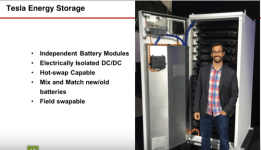MitchJi
10 MW
Hi,
When the Powerpack prices of $250 per kWh were announced I thought we could use those prices to reach several conclusions:
1. Their Powerpack prices of $250 per kWh are below deeply disruptive and this market is huge:
Why Energy Storage is About to Get Big and Cheap | Ramez Naam
http://rameznaam.com/2015/04/14/energy-storage-about-to-get-big-and-cheap/
2. We can use the Powerpack price to get a much better idea of their car pack costs than were possible before.
3. Their prices are lower than anyone knows, and Tesla has been, and continues to hide them.
4. When you factor in the GF cost reductions at about the end of 2016 or mid 2017 their prices will be at least close to being disruptive, and definitely low enough that producing and affordable M3 is going to be a slam dunk.
Based on the following a reasonable post GF estimate (mid to late 2017) that Tesla could sell their packs for is ($180 x 70% = $126 per kWh):
http://learnbonds.com/120435/tesla-...y-costs-lower-than-most-optimistic-forecasts/
When the Powerpack prices of $250 per kWh were announced I thought we could use those prices to reach several conclusions:
1. Their Powerpack prices of $250 per kWh are below deeply disruptive and this market is huge:
Why Energy Storage is About to Get Big and Cheap | Ramez Naam
http://rameznaam.com/2015/04/14/energy-storage-about-to-get-big-and-cheap/
2. We can use the Powerpack price to get a much better idea of their car pack costs than were possible before.
3. Their prices are lower than anyone knows, and Tesla has been, and continues to hide them.
4. When you factor in the GF cost reductions at about the end of 2016 or mid 2017 their prices will be at least close to being disruptive, and definitely low enough that producing and affordable M3 is going to be a slam dunk.
Based on the following a reasonable post GF estimate (mid to late 2017) that Tesla could sell their packs for is ($180 x 70% = $126 per kWh):
Tesla Motors Inc (TSLA) Drives Battery Costs Lower Than Most Optimistic ForecastsJaffe said that Panasonic is selling Tesla Powerpacks at a rate of $180 per kWh.
http://learnbonds.com/120435/tesla-...y-costs-lower-than-most-optimistic-forecasts/
One example of close to being disruptive is that with a 30% reduction in costs Tesla could sell the new 90 kWh pack in a 120 kWh version for the same price. That is a 400 mile range! I realize it might take a 2-3 years to increase the energy density to the point where that's practical, but they are getting close! I'm not sure where the "tipping point" is but I am positive that a 400 mile range makes the cut! Gas powered cars are on the way out, and Tesla is leading the way!Two years ago Tesla Motors (NASDAQ:TSLA) said that it had already beaten the $250/kWh mark. CTO JB Straubel said, in an interview with Technology Review, that battery costs were “way less than half, actually, less than a quarter in most cases.” That puts the estimated cost of the cells in a Tesla Motors 85kWh Model S at just under $240.
That piece was published back in 2013, long before the Gigafactory began its testing phase. It’s was also before Tesla Motors got in touch with key Li-ion expert Jeff Dahn and made a deal to lower the unit cost of batteries in its EVs...
It’s likely that Tesla Motors battery costs are below $200 per kWh right now, but the firm doesn’t reveal that closely guarded secret too easily. Power cells are the area in which the firm is way ahead of other EV makers. It wants to We're all kind of saying the same things. The Model X is already known. Mr. Market also has factored in that there is demand for the product, although the lingering question of whether the demand is niche or not dances in some people's minds (not mine). The delivery of a few X's that success to itself for the time being.
Navigant Research’s Sam Jaffe is certain that Tesla Motors is below that level, and he reckons the firm has been below it for quite a while. In an October 2014 UBS report on EVs, which focused on battery costs, Jaffe said that Panasonic is selling Tesla power packs at a rate of $180 per kWh...
Tesla Motors (NASDAQ:TSLA) has never offered the clearest view on its inner workings in its earnings reports, despite the transparent measures the firm has taken in other areas. It’s not really clear how much the firm is paying per kWh of power in a Li-Ion pack, but it’s likely that its costs are lower than other players in the market.
All of this is guesswork, but some of it is more informed than others. It’s unlikely that Tesla Motors is still stuck above the $250 kWh level for batteries, and it’s likely that the firm has gotten those costs down to below $200.


